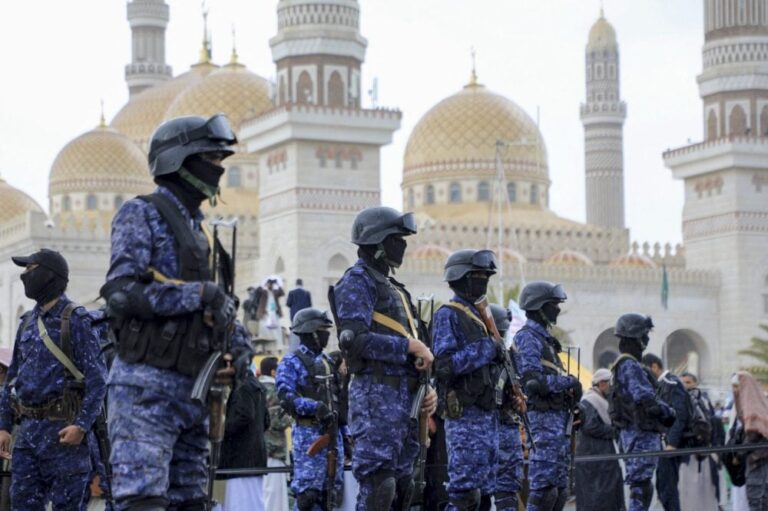In early December 2023, I interviewed a former senior Israeli intelligence official about Hamas’ October 7 attacks and the rapidly changing dynamics of the Middle East. He explained that on October 7, “there was an earthquake, so the whole region will be dealing with aftershocks for quite some time.”
Although he did not predict where the aftershocks would occur, his comprehensive predictions of deep shaking proved surprisingly clairvoyant. More than a year later, Hamas has been decimated as a fighting force and its senior leaders assassinated. Hezbollah has caused severe bloodshed, with longtime leader Hassan Nasrallah and much of his top command killed. And Syria’s Assad regime has collapsed and its longtime dictator has been ousted. Indeed, as a result of these aftershocks, the geopolitical situation in the Middle East has changed completely.
In early December 2023, I interviewed a former senior Israeli intelligence official about Hamas’ October 7 attacks and the rapidly changing dynamics of the Middle East. He explained that on October 7, “there was an earthquake, so the whole region will be dealing with aftershocks for quite some time.”
Although he did not predict where the aftershocks would occur, his comprehensive predictions of deep shaking proved surprisingly clairvoyant. More than a year later, Hamas has been decimated as a fighting force and its senior leaders assassinated. Hezbollah caused severe bloodshed, with long-time leader Hassan Nasrallah and much of his top command killed. And Syria’s Assad regime has collapsed and its longtime dictator has been ousted. Indeed, as a result of these aftershocks, the geopolitical situation in the Middle East has changed completely.
But with a ceasefire in Lebanon, the prospect of one in Gaza looming, and Syria’s new leaders busy consolidating their country, the question today is: Are the aftershocks of October 7 finally coming to an end? Please. After all, US President-elect Donald Trump vowed to quickly “end war” before taking office, and incoming defense officials have signaled that they intend to reorient the United States towards the Indo-Pacific. But in reality, leaving the Middle East may prove more difficult than they expected. As the region heads into 2025, aftershocks are almost certain to continue, threatening U.S. interests for some time to come.
The first tremors have probably already begun in Yemen. The Houthis have been preying on international shipping in the Red Sea for more than a year, despite efforts by the US-led coalition to thwart attacks. But in recent weeks, the Houthis have stepped up attacks on Israel, launching more than 200 missiles and more than 170 drone strikes. Although Israel and the United States have blunted most of these attacks, their frequency has increased, increasing pressure on the Israeli government for a stronger response. Not surprisingly, Israeli warplanes attacked Yemeni ports and other infrastructure to deter further missile attacks by the Houthis. But the Houthis appear unyielding to Israeli retaliation, and Israeli leaders have no intention of backing down. Israeli Prime Minister Benjamin Netanyahu recently vowed that “the Houthis will learn what Hamas, Hezbollah, the Assad regime, and others have learned.”
Such bellicose rhetoric would soon run up against military reality. After all, the Houthis endured years of Saudi-led air operations during Yemen’s civil war. Yemen is more than 1,300 miles from Israel, making sustained air operations much more logistically complex for Israel than in neighboring Gaza or Lebanon. What’s more, Israel has considered Hezbollah its main adversary since at least 2006 and has spent more than a decade preparing to fight it. This preparation paid off, as evidenced by Israel’s dramatic attack, which was based on an elaborate infiltration of Hezbollah’s walkie-talkie and beeper supply chain. In contrast, Israel until recently did not consider the Houthis to be an immediate threat, and is perhaps less sophisticated now. The operation against the Houthis may not be as swift or spectacular as the destruction of Hezbollah.
However, just because Israel may be involved in a long-term campaign to annihilate the Houthis, it does not mean that it will not try. Immediately, new strikes will destroy much of what is left of Yemen’s dilapidated infrastructure. Israeli airstrikes have so far focused on the Houthi-held ports of Hodeidah, Salih, and Ras Khantib, as well as Sanaa International Airport, all aimed at cutting off Iranian weapons shipments to the Houthis. are. Israel has also vowed to target the Houthi leadership, a step both Israel and the United States have so far avoided. If these efforts are successful, the Houthis’ military capabilities could eventually be reduced, if not completely eliminated. But in the short term, Israel will need U.S. support to counter Houthi missiles and drones, and international shipping will need to rely on a U.S.-led naval coalition to safely transit the Red Sea. Some Israeli analysts are also aware of this.
At the same time, new military action could have ripple effects across the Arabian Peninsula. In 2020, the United Nations estimated that 70% of all Yemeni imports and 80% of all humanitarian aid, including much of its food, transited through the same ports as Iranian weapons. Cutting off the flow of arms from Iran would destabilize an already fragile humanitarian situation, given that around 21 million Yemenis, two-thirds of the total population, depend on this aid. It may also mean that. Even if the Trump administration remains unfazed by the humanitarian plight, it will need to consider the possibility that the conflict in Yemen could spill over into neighboring Saudi Arabia and threaten global energy supplies.
If the Houthis are one aftershock, Iran is another, and potentially more significant, aftershock. Israel and Iran have long been fighting a shadow war that has come to the fore since October 7th. In addition to providing weapons to a number of proxy groups, including Hamas, Hezbollah, and the Houthis, Iran has launched two large-scale missile and drone attacks directly on Israel, and Israel has attacked Iranian military facilities in retaliation. It’s attacking. Indeed, in a series of interviews from November 2024, Israeli security services framed the October 7 and subsequent war as one large-scale war against Iran with Hamas, Hezbollah, and the Houthis. It is merely a pawn in a larger conflict with the Tehran regime.
Iran has had a disastrous year, with one proxy after another suffering defeats and Israeli airstrikes stripping it of its state-of-the-art air defenses. But a weakened Iran is, in some ways, just as dangerous. Iran is doubling down on its nuclear program in response to the deteriorating security situation. This will bring Iran into conflict not only with Israel but also with the United States and other Western countries. The Trump administration has signaled it will return to its maximum pressure campaign of sanctions against Iran, but the administration may be just weeks away from the bombing and sanctions could act quickly enough to prevent a nuclear explosion. The question arises as to whether or not.
As if the Houthis and Iran weren’t enough, there are countless other fault lines in the region that are rumbling quietly but audibly. Syrian politics are still far from resolved, and sectarian tensions could flare up again. On the Mediterranean coast and in Damascus, Syria’s new rulers are clashing with elements of the old regime, as the Alawite minority protests against rule by the Sunni Arab majority. In northern Syria, fighting between Turkish-backed forces and Kurds is intensifying, and there is a risk that the Turkish-Kurdish conflict could reignite and spill over into Iraq.
And if NATO ally Turkey fighting the Kurds, a longtime ally of the United States, wasn’t enough to keep the United States involved, the Kurdish-majority Syrian Democratic Forces are still in numbers. It holds 1,000 Islamic State prisoners. If they are released, Islamic State’s influence will increase. That would be a pressing problem for Iraq, Jordan, and other regions, but given the group’s nature as a global terrorist organization, its reemergence would ultimately be a problem for the United States as well.
This brings us to a fundamental challenge for the next U.S. administration. Like the first Trump administration, and by extension the Obama and Biden administrations, the incoming team wants to withdraw from the Middle East. But getting out comes at a price. If the Houthis are left alone, they could continue to attack one of the world’s busiest sea lanes, rain missiles on Tel Aviv and spill violence into Saudi Arabia. If we ignore the Iranian issue, there is a risk that a country whose president takes office shouting “Death to America” and “Death to Israel” will acquire nuclear weapons, not to mention causing further nuclear proliferation in the unstable Middle East. Become. A complete withdrawal from Syria risks the resurgence of Islamic State and jihadist terrorism.
That’s the problem with earthquakes and aftershocks. At best, we can use the devastation to build something better in the aftermath, or we can simply try to mitigate the damage. You can also ignore their effects completely and accept the results. But at the end of the day, we can’t stop the shaking from happening.
The same holds true for the incoming Trump administration’s Middle East policy. Like its predecessor, you can choose how to respond to the ongoing chaos in the Middle East with more or less effectiveness, but just as a spell can stop an earthquake, an executive order can end chaos. I can’t do that.


